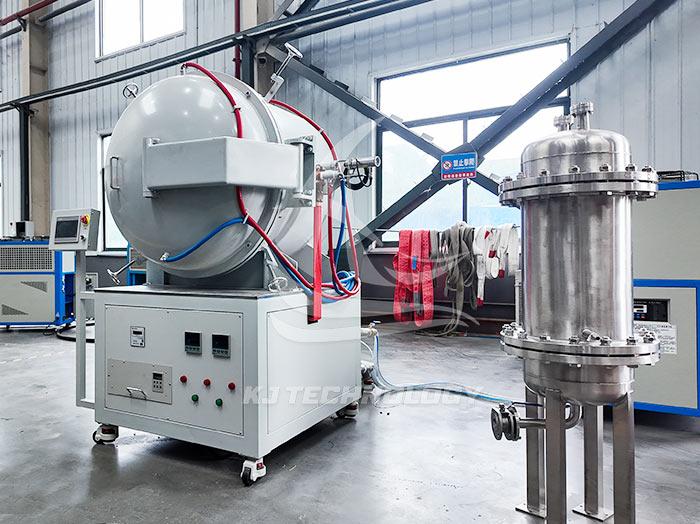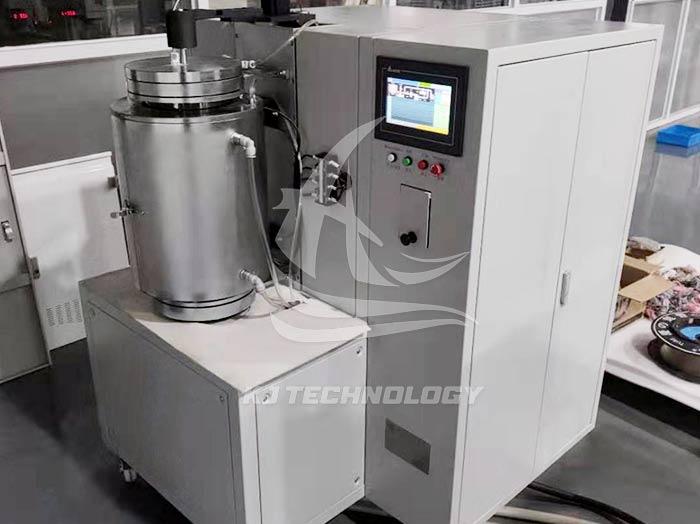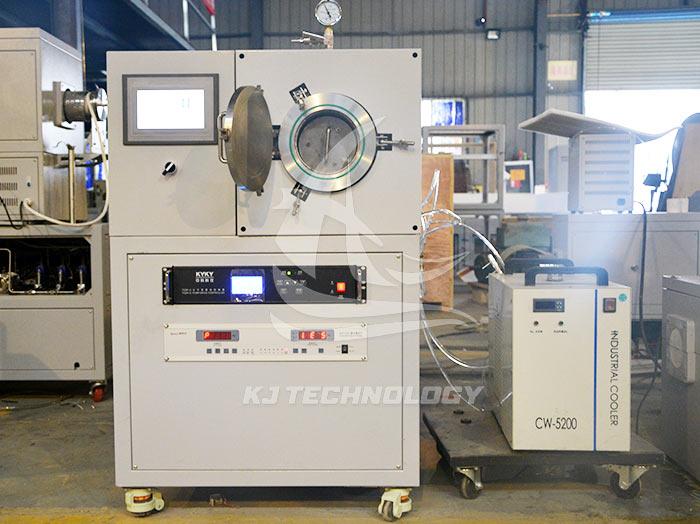Working principle of electric heating high-temperature vacuum heat treatment furnace
 06-06-2025 Author: KJ technology
06-06-2025 Author: KJ technology
The electric heating high-temperature vacuum heat treatment furnace achieves precise heat treatment of materials under non oxidizing and non polluting conditions through the collaborative work of three core modules: vacuum environment control, electric heating system, and temperature regulation. Its working principle can be decomposed into the following key steps:
1. Construction of Vacuum Environment
Composition of vacuum system
Mechanical pump+diffusion pump/molecular pump: The mechanical pump pre pumps to 10 ⁻¹~10 ⁻² Pa, and the diffusion pump/molecular pump further pumps to 10 ⁻³~10 ⁻⁶ Pa, meeting the high cleanliness requirements.
Vacuum gauge monitoring: Real time monitoring of furnace pressure using resistance gauge (low vacuum) and ionization gauge (high vacuum).
Sealing structure: The furnace body adopts double-layer water-cooled metal sealing rings (such as copper gaskets) to ensure a vacuum leakage rate of ≤ 1 × 10 ⁻⁹ Pa · m ³/s.
The role of vacuum environment
Inhibition of oxidation: Avoid metal materials from reacting with oxygen at high temperatures to form an oxide layer, such as titanium alloys that are prone to brittle TiO ₂ formation when heated in air.
Reduce gas pollution: eliminate impurities such as hydrogen and nitrogen to prevent hydrogen embrittlement or nitriding reactions. For example, stainless steel can avoid intergranular corrosion during vacuum annealing.
Promoting diffusion: reducing the hindrance of gas molecules to atomic diffusion and accelerating atomic migration during sintering or brazing processes.
2. Working mechanism of electric heating system
Heating element type
Graphite heating element: resistant to high temperatures (up to 2800 ℃), suitable for high-temperature sintering and heat treatment, but prone to oxidation and needs to be used in a vacuum or inert atmosphere.
Molybdenum/tungsten wire: High temperature strength, suitable for environments below 1600 ℃, commonly used for vacuum annealing and brazing.
Silicon molybdenum rod (MoSi ₂): has good oxidation resistance, can be used at a temperature of 1700 ℃, and is suitable for air or vacuum environments.
Heating principle
Resistance heating: Current passes through a heating element to generate Joule heat (Q=I ² Rt), which is then transferred to the workpiece through radiation and convection.
Temperature gradient control: using multi zone independent temperature control (such as 3-6 zones), real-time temperature feedback through thermocouples (K-type, S-type), and PID controller to adjust power output.
Heat transfer mode
Radiation is predominant: At high temperatures (>800 ℃), radiation heat transfer accounts for more than 90%. Coating the surface of the workpiece with a high emissivity coating (such as silicon carbide) can improve heating efficiency.
Convection assistance: In the low temperature stage (<600 ℃), the addition of inert gas enhances convective heat transfer and shortens the heating time.
3. Temperature control and process execution
Temperature control process
Set process curve: Input parameters such as heating rate, holding time, and cooling rate based on material characteristics (such as titanium alloy solution treatment: 950 ℃/1h/furnace cooling).
Real time monitoring and adjustment: Thermocouples collect temperature signals, PLC or computer systems compare set values with actual values, and dynamically adjust heating power.
Security protection: functions such as over temperature alarm (usually set at upper limit temperature+50 ℃), couple break protection, and water cooling system fault alarm ensure equipment safety.
Typical Process Cases
Vacuum brazing:
Heat up to the melting point of the brazing material (such as AgCu brazing material: 780 ℃), hold for 10-15 minutes, and allow the brazing material to fully fill the joint gap.
During the cooling stage, high-purity nitrogen gas (pressure 0.1~0.2MPa) is injected to accelerate cooling and prevent coarsening of solder grains.
High temperature sintering:
Hard alloy sintering: 1450 ℃/2h, vacuum degree ≤ 10 ⁻ Pa, obtain a dense body with a density of ≥ 99%.
Ceramic material sintering: 1600 ℃/3h, adjusting the oxygen vacancy concentration by controlling the oxygen partial pressure (filling a small amount of Ar/O ₂ mixture).
4. Collaborative auxiliary system
Cooling system
Water cooling cycle: cooling furnace shell, electrodes, vacuum valves and other components to prevent high-temperature deformation or sealing failure.
Gas cooling acceleration: During the cooling stage, inert gas (such as Ar) is filled, and the cooling rate can reach 5-10 ℃/min, shortening the process cycle.
Atmosphere control system
Inflatable function: It can be filled with gases such as Ar, N ₂, H ₂, etc., to achieve reducing or inert atmosphere protection.
Partial pressure control: By adjusting the gas flow rate and vacuum pump pumping speed, the oxygen partial pressure inside the furnace can be precisely controlled (such as oxygen partial pressure<10 ⁻² ¹ Pa for zirconium alloy heat treatment).
5. Summary of Technical Advantages
Non oxidation treatment: avoids the formation of an oxide layer on the surface of the material, improves mechanical properties and corrosion resistance.
High cleanliness: eliminates impurity gases, reduces the generation of inclusions, suitable for high-end fields such as semiconductors and aerospace.
Accurate temperature control: temperature uniformity within ± 5 ℃, meeting high-precision heat treatment requirements.
Energy saving and efficient: The double-layer water-cooled furnace shell and high-efficiency insulation material reduce heat loss, and energy consumption is reduced by more than 30% compared to traditional furnace types.
6. Application scenario extension
Aerospace: Heat treatment and brazing of titanium alloys and high-temperature alloys.
Electronic packaging: eutectic soldering of ceramic substrates and metals.
Powder metallurgy: high-temperature sintering of hard alloys and magnetic materials.
New energy: Vacuum diffusion welding of fuel cell bipolar plates.
Through the above principles, the electric heating high-temperature vacuum heat treatment furnace has achieved high-performance processing of materials under extreme conditions, becoming an indispensable core equipment in modern high-end manufacturing.








